Chai spices are prepared in different ways. A spiced simple syrup yield isgreater—usually 4-6 servings—than a paste with ginger—1 or 2 servings. A third type, a decoction in boiled water with sugar, has milk added at the end of the simmering time, and can make enough for 2-3 servings. A spiced syrup, wonderful if you like your drinks on the sweet side, can be stored in the fridge for up to one month.
Divya Alter’s What to Eat for How You Feel (published by Rizzoli International, 2017)is an Ayurvedic cookbook created from the author’s years of experience and deeply held convictions about how to cook delicious food for health. Besides recipes for seasonal dishes, Divya instructs readers on the best way to use spices and Ayurvedic cooking wisdom. Something that most home cooks are shy to admit—or maybe not shy about—that salt and pepper are the sum total of spices they feel comfortable with! 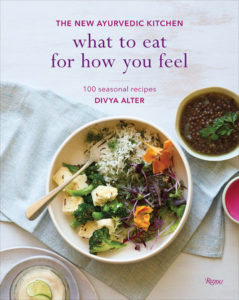
Her “Almond Milk Chai” is particularly suited to the dosha type drinking it. The recipe makes enough for two or three servings and is achieved by simmering the spices in water until the liquid is reduced, then adding almond milk and sweetener.
Vata types can use her recipe as is—it contains 10 peppercorns, 5 cardamom pods, 1 tablespoon of fresh grated ginger and 1 1/2 cinnamon sticks, sweetener, water, and almond milk. Cloves and star anise are part of her recipe, too. You’ll cook and simmer the spices whole in water in a longer simmering time—half an hour!
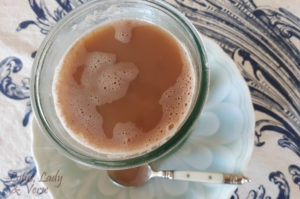
Her chai is meant to be boiled without black tea, and the result is a healthful and heat-generating drink—great for digestion!
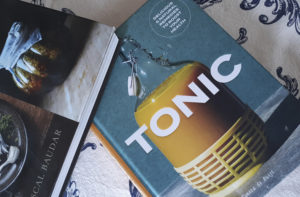 Tanita de Ruijt‘s Tonic, reviewed here, is a slight deviation from traditional chai, because her recipe adds turmeric. Hence the name “Chai Tonic”. In herbalism, this is a popular method of preparing certain spices such as turmeric that renders them more available for digestion. A paste, rather than a powder, makes the spice easier to add to liquid and reduces simmering time. Her recipe is one of the best for tonic chai and can be prepared in a few minutes.
Tanita de Ruijt‘s Tonic, reviewed here, is a slight deviation from traditional chai, because her recipe adds turmeric. Hence the name “Chai Tonic”. In herbalism, this is a popular method of preparing certain spices such as turmeric that renders them more available for digestion. A paste, rather than a powder, makes the spice easier to add to liquid and reduces simmering time. Her recipe is one of the best for tonic chai and can be prepared in a few minutes.
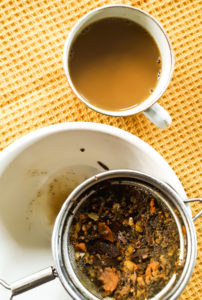 If you know about turmeric, that’s fantastic. Maybe you believe it’s too bitter without sugar? Most chais and golden milk recipes are okay with sugar… But more to the point: spices have better balance and taste when used in the right proportions and in combination with other spices.
If you know about turmeric, that’s fantastic. Maybe you believe it’s too bitter without sugar? Most chais and golden milk recipes are okay with sugar… But more to the point: spices have better balance and taste when used in the right proportions and in combination with other spices.
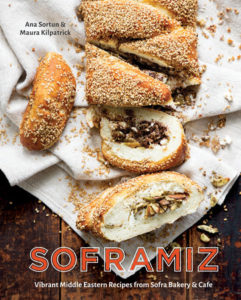 Serious about cooking or baking with a Mediterranean or Middle Eastern flair? If so, then Soframiz: Vibrant Middle Eastern Recipes from Sofra Bakery and Cafe (published by Ten Speed Press, 2016) is a vital addition to your cookbook collection. Authors Ana Sortun, accomplished chef and restaurateur, and Maura Kilpatrick, pastry chef par excellence, share their expertise in Soframiz, which means “Sofra’s table”, roughly translated from Turkish. Your main dishes, sides and desserts, plus drinks, breads and pastries made from Soframiz’s recipes will delight and amaze. I cannot put my finger on why but perhaps it’s the marriage of taste with what Sortun chooses to cook that makes her books so appealing. See my review of Spice: Flavors of the Eastern Mediterranean, here. Or visit Sofra Bakery and Café in Cambridge to experience what’s now a very hot spot for breakfast, lunch and lighter fare. If you’re not yet a master baker or spice master like these women are, you can still appreciate the best and manage yours a sophisticated style of cooking with this book.
Serious about cooking or baking with a Mediterranean or Middle Eastern flair? If so, then Soframiz: Vibrant Middle Eastern Recipes from Sofra Bakery and Cafe (published by Ten Speed Press, 2016) is a vital addition to your cookbook collection. Authors Ana Sortun, accomplished chef and restaurateur, and Maura Kilpatrick, pastry chef par excellence, share their expertise in Soframiz, which means “Sofra’s table”, roughly translated from Turkish. Your main dishes, sides and desserts, plus drinks, breads and pastries made from Soframiz’s recipes will delight and amaze. I cannot put my finger on why but perhaps it’s the marriage of taste with what Sortun chooses to cook that makes her books so appealing. See my review of Spice: Flavors of the Eastern Mediterranean, here. Or visit Sofra Bakery and Café in Cambridge to experience what’s now a very hot spot for breakfast, lunch and lighter fare. If you’re not yet a master baker or spice master like these women are, you can still appreciate the best and manage yours a sophisticated style of cooking with this book.
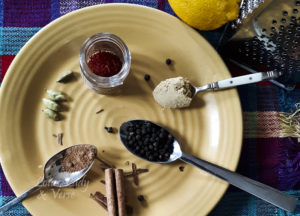 The syrup in Sortun’s recipe Sofra’s Chai has a rich flavor. It smells and tastes like gingerbread to me! How exciting added to tea! Perhaps even coffee? Made of water and sugar, 2 teaspoons black peppercorns, 4 green cardamom pods, 2 cinnamon sticks and ½ teaspoon of ground ginger, two more ingredients plus black tea and milk for serving. Lemon zest and ground nutmeg are the two surprising ingredients, and at the end of the syrup cooking time, you’ll pinch a tiny bit of saffron from your stash of it to sprinkle in. The spiced simple syrup tastes just like a dessert itself!
The syrup in Sortun’s recipe Sofra’s Chai has a rich flavor. It smells and tastes like gingerbread to me! How exciting added to tea! Perhaps even coffee? Made of water and sugar, 2 teaspoons black peppercorns, 4 green cardamom pods, 2 cinnamon sticks and ½ teaspoon of ground ginger, two more ingredients plus black tea and milk for serving. Lemon zest and ground nutmeg are the two surprising ingredients, and at the end of the syrup cooking time, you’ll pinch a tiny bit of saffron from your stash of it to sprinkle in. The spiced simple syrup tastes just like a dessert itself!
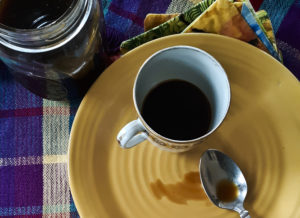 In most recipes for chai made with simple syrup, the black tea is brewed separately, and this one is no exception. Once you’re ready to serve—which could be the next day—combine the two and add milk. Very convenient!
In most recipes for chai made with simple syrup, the black tea is brewed separately, and this one is no exception. Once you’re ready to serve—which could be the next day—combine the two and add milk. Very convenient!
For two spices which sweeten like licorice, see the continuation on chais, here.
Follow


